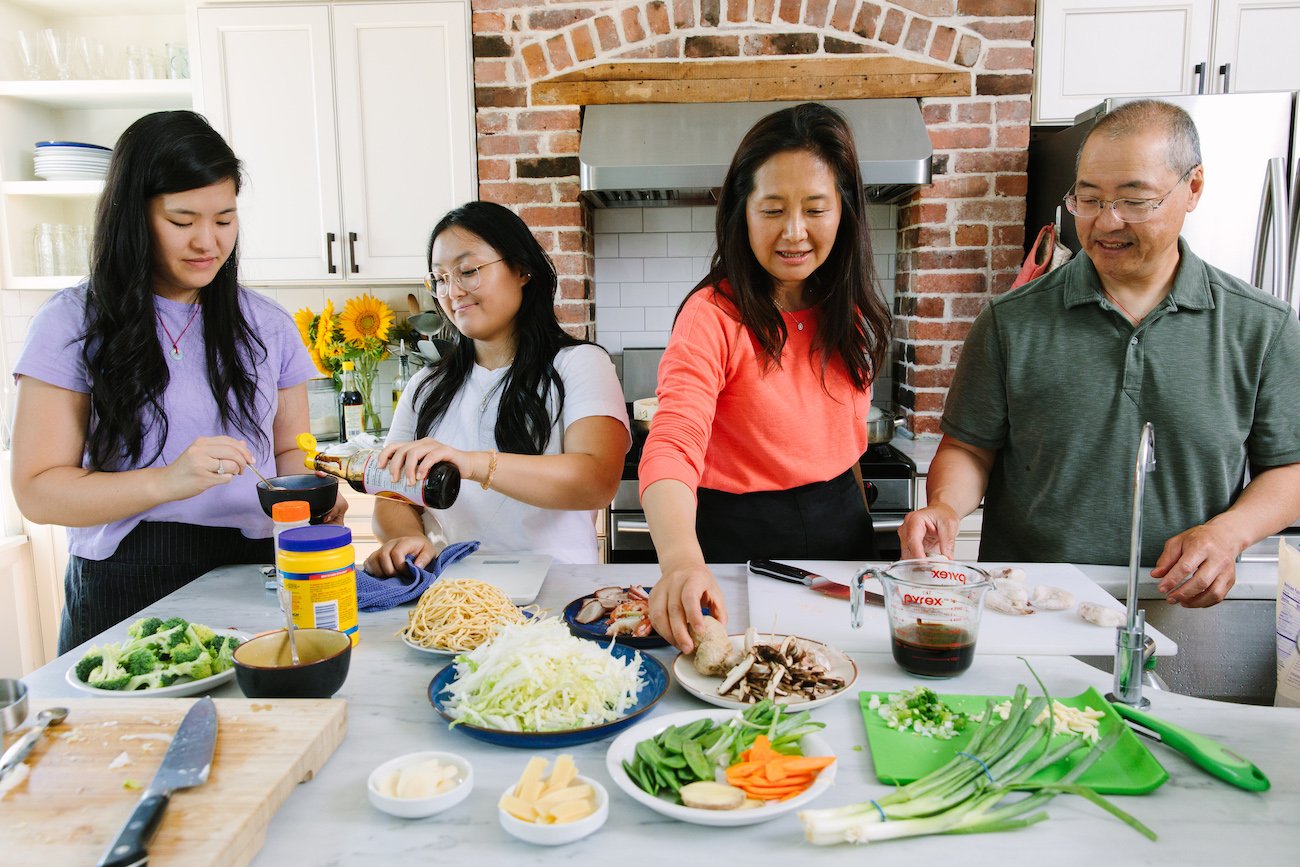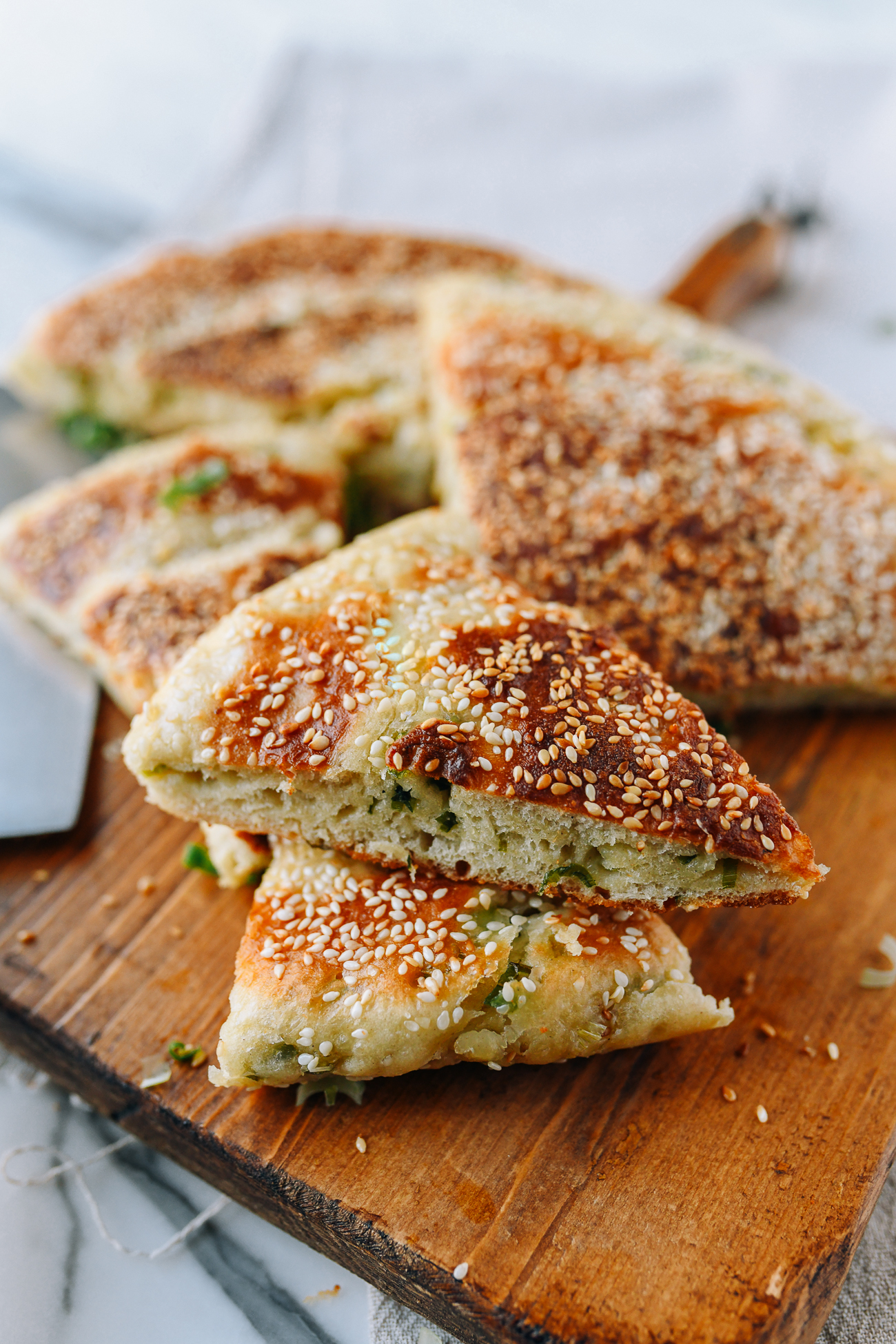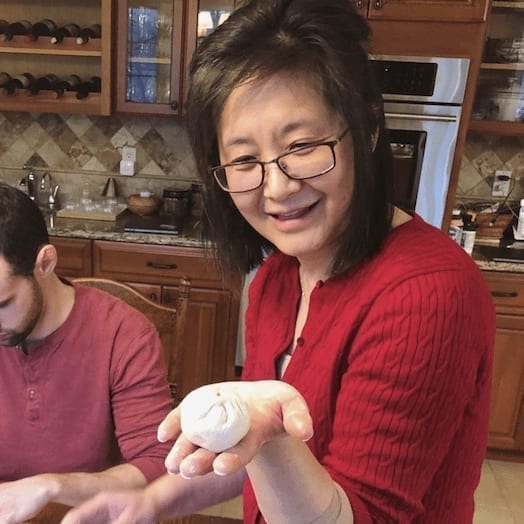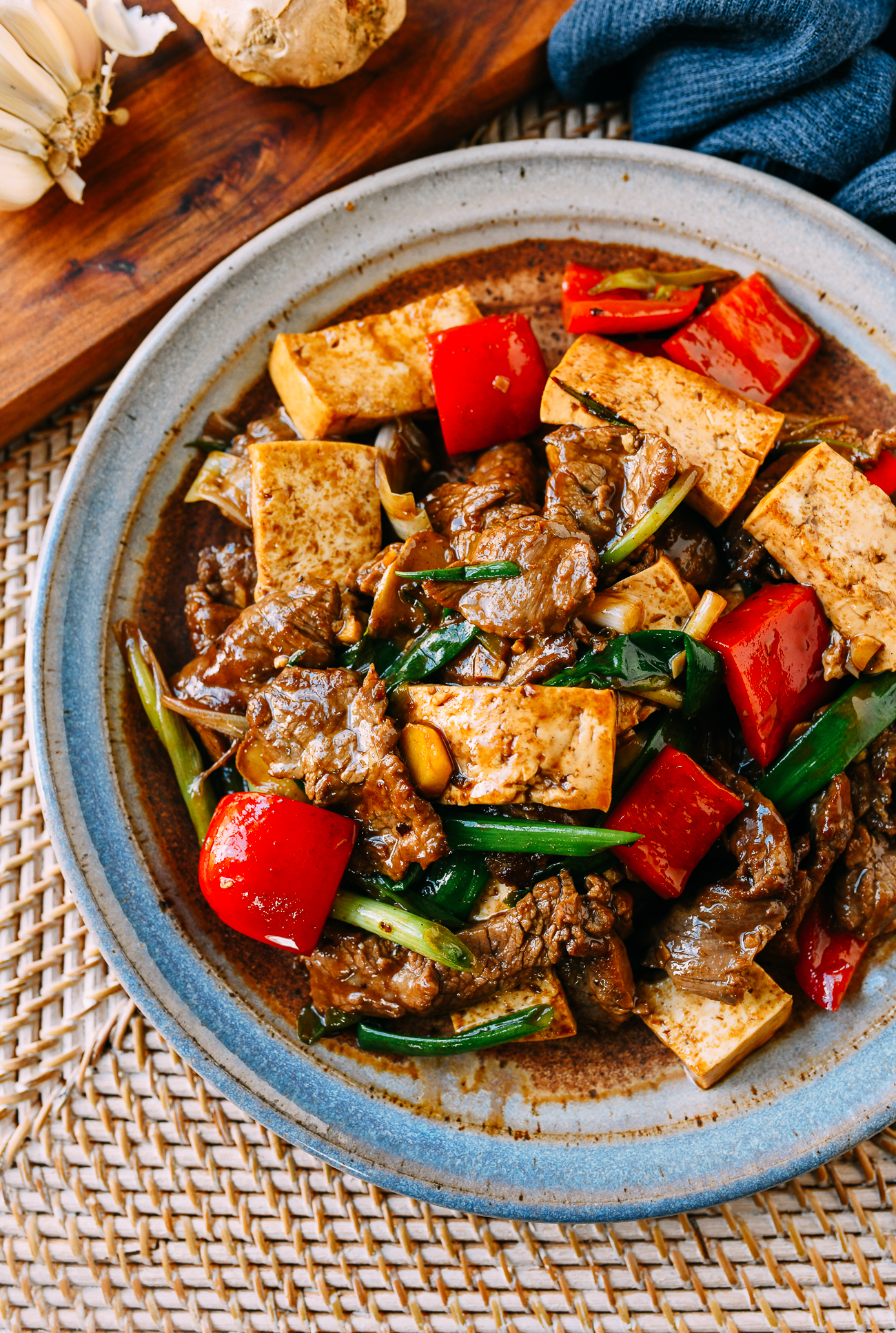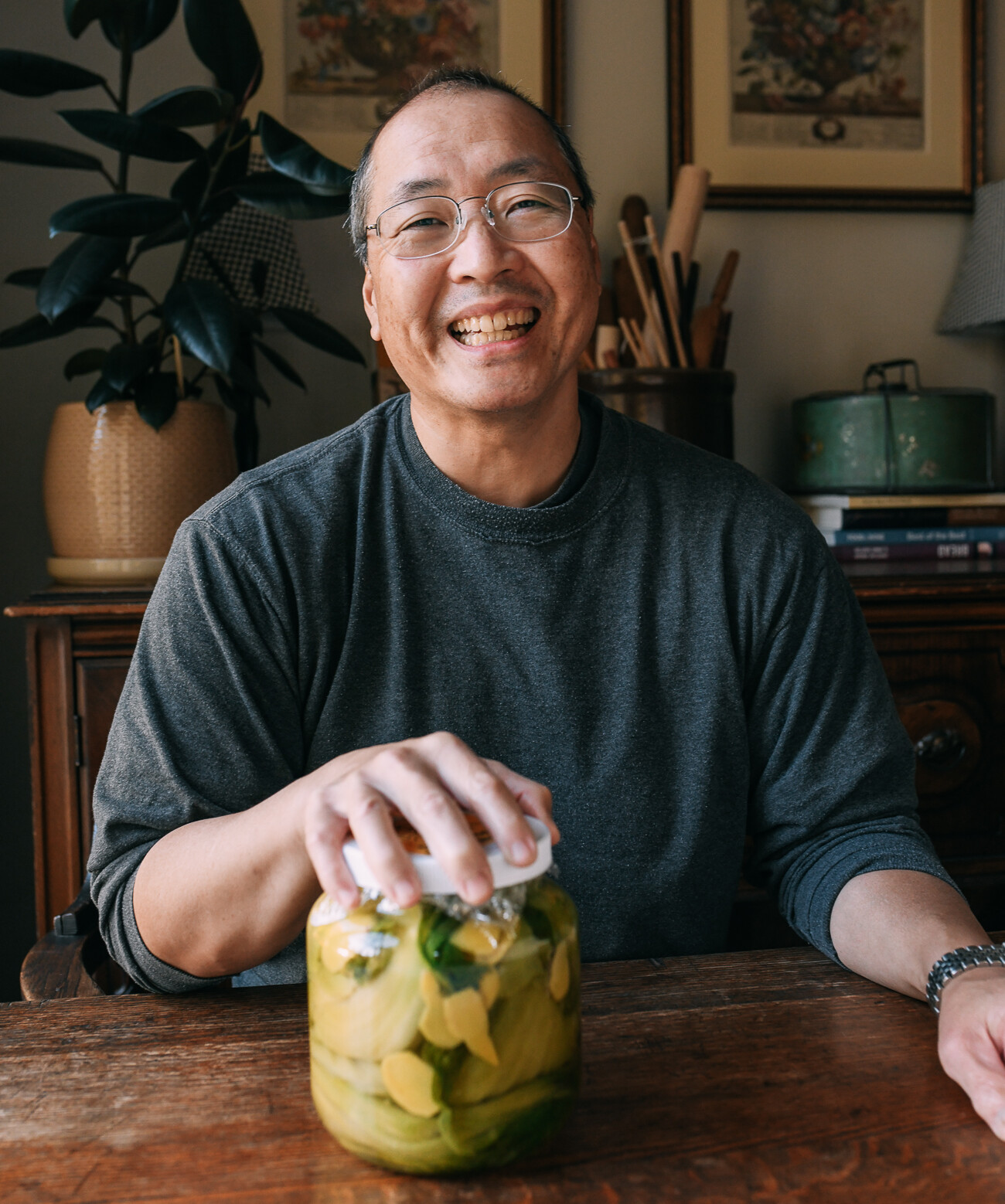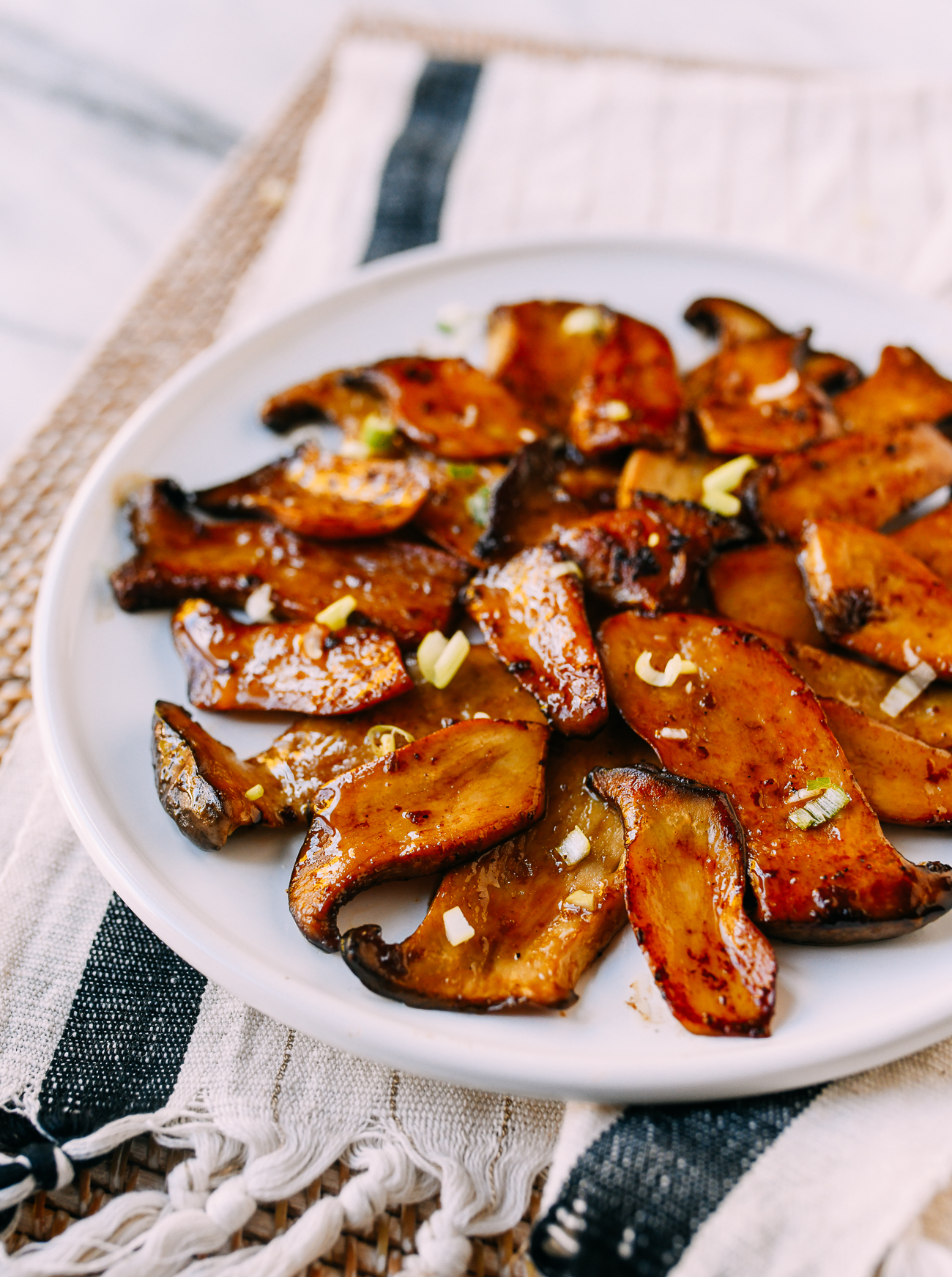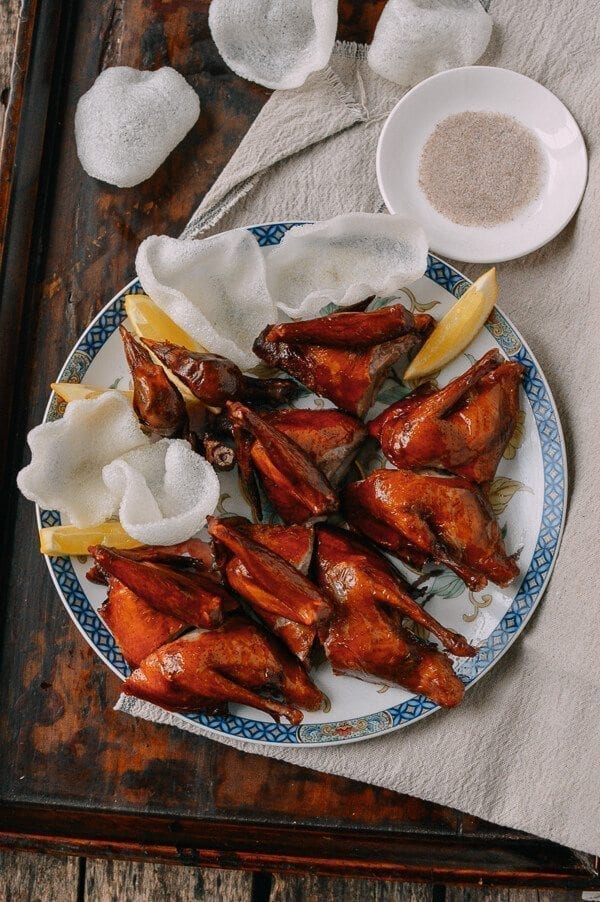
Chinese Fried Pigeon (Zha Ge Zi, 炸鸽子) or Chinese Fried Squab (Zha Ru Ge, 炸乳鸽) is an incredibly special dish and a Hong Kong classic. In the Cantonese dialect, we commonly call it Zha Bok Gop, and it used to be a favorite served up in 10-course Chinese banquets for weddings, birthdays, and, of course, Chinese New Year celebrations.
However, in recent years, this dish has almost disappeared from Chinese banquet menus here in the US–mostly because of cost. That said, you can still order zha bok gop a la carte off the menu in some places but the price is steep.
What’s the Difference Between Pigeon and Squab?
To clarify the difference between “pigeon” and “squab,” a squab is essentially a domesticated, farmed, young pigeon. We’re not sure where the cost differential comes from, but in Hong Kong and China, you can order fried pigeons for about 20 RMB or just over 3 US dollars apiece.
However, here in the US, it costs $12.95 for each uncooked pigeon and about $18.00 per serving at a restaurant! With one squab per person, a plate of squab for a family of four is pretty pricey. Even if restaurants served a quarter of a pigeon per person, that translates to three whole pigeons at a table of 12 at a Chinese banquet.
So you can imagine that after factoring food costs, the labor-intensive cooking process, and the lack of payoff in terms of quantity for the diner, that most restaurants are sadly passing on this dish for their banquet lineup.
Preserving Tradition
When Judy and I lived in Beijing, we loved ordering fried pigeon, because it was so ridiculously cheap, and squab is an extremely tasty bird! When it’s done right, it is truly impressive and satisfying, especially when dipped into a little five-spice salt and finished with a squeeze of lemon.
Now that we’re back in the US, we decided it was time to learn how to make this dish at home for our own Chinese New Year celebrations and special occasions. While $12.95 a piece is pricey, we can’t put a value on preserving what’s now become a very rare dish.
Mastering a traditional Chinese fried pigeon, bringing back some fond food memories, and adding another important recipe to our family archives? Priceless, as they say.
You’ll find that this fried pigeon recipe is a bit more advanced. It really unleashes quite a few cooking secrets and techniques that any Chinese master chef or Si Fu (Cantonese) or Shi Fu (Mandarin) (师傅) would be proud of!
Read the recipe carefully before getting started, follow the directions closely, and you’ll be amazed that you can cook this Chinese Fried Pigeon Zha Bok Gop dish at home.
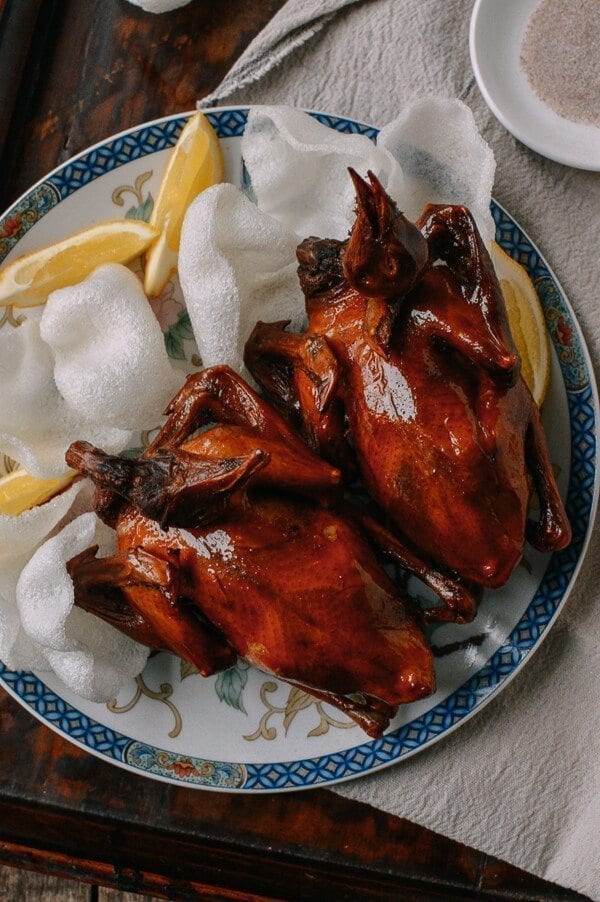
Serve this fried pigeon dish on Chinese New Year or at your next special family dinner, and you will be forever known as a rock star chef! Serve them with some Shrimp Chips – Ha Peen, as they are traditionally, and you’ll be even more of a legend!
Note also that these premade Chinese spice packets are really handy for this recipe, but if you cannot find them, you can use Judy’s made-from-scratch spice packet in her Chinese braised beef shank recipe.

Chinese Fried Pigeon Recipe Instructions
Make sure the pigeon/squab are cleaned well, removing any internal organs. Squab in the US almost always come frozen, and oftentimes, they only come dressed on the outside, which means that you must cut a small opening near the tail in order to remove the remove the organs and clean the inside.
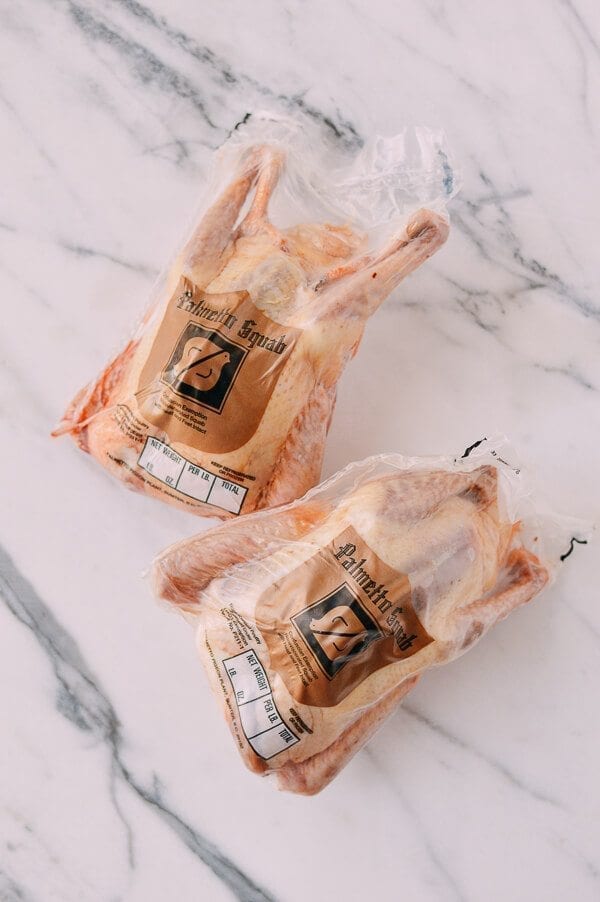
Take care to cut a small opening, and not to rip the skin when cleaning it. The best cut to make is a small horizontal cut 1 to 1½ inches wide between the tail and the bottom of the breast. It’s the same place where all poultry are cut and cleaned out.
Once the cut is made, you’ll have to carefully use two fingers to pull out the entrails–including the heart, gizzard, liver, lungs and any glands that are attached to the cavity. It will take a few passes and lots of rinsing with cold water to get them cleaned out.
After the insides are thoroughly cleaned, use kitchen shears to clip off the talons and tuck the feet inside the cavity. You can also just cut off the claws (some old folks like to eat them with a cold beer) and just leave the legs. For a Chinese New Year bird, Chinese people tend to leave the legs, tail, and head intact.
It is an old Chinese tradition to serve any bird with both the head and tail on for Chinese New Year dinner. It’s true also for the classic poached chicken, Cantonese white cut chicken, which is a required dish at all Cantonese Lunar New Year dinners!
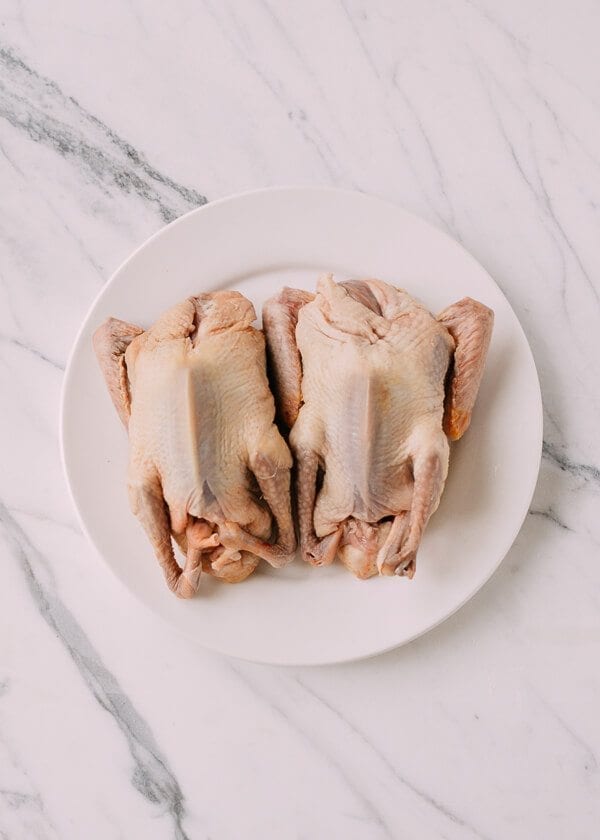
In a medium-sized pot, add the ginger slices, garlic, scallion, rock sugar (or granulated sugar), salt, Shaoxing wine, light soy sauce, Chinese spice packet, and water. Bring it to a boil. The liquid should be quite salty––almost as salty as the sea, like when you cook pasta since the cooking time is short. Turn the heat down and let the sauce simmer for 15 minutes.
Next, carefully place the squab into the pot until they are fully submerged, and the cavities are filled with the hot liquid.
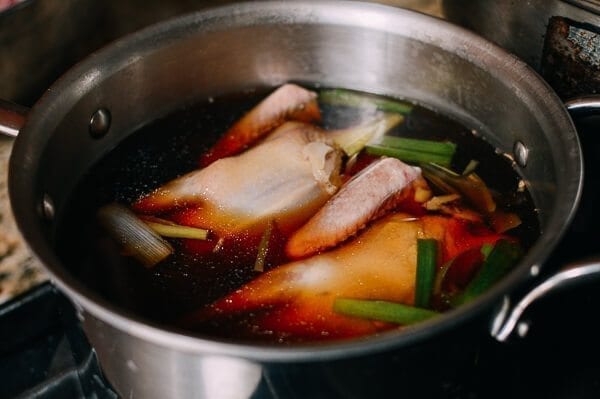
Lift the squab out, emptying the liquid inside the cavity and return them back to the pot, again ensuring there are no air pockets in the cavity. This is the same method used in our classic Cantonese poached chicken; it ensures that there are no cold spots and that the poultry cooks evenly.
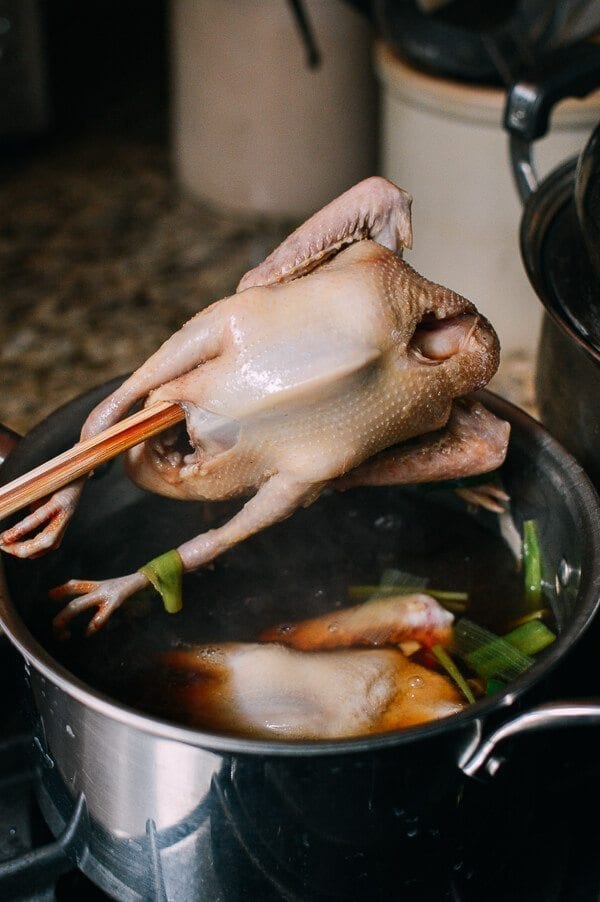
Reduce the heat to the lowest setting so the liquid is almost (but not actually) simmering. Let the squab cook for 30 minutes. Another easier method is to let the liquid simmer for 5 minutes with the squab, then turn off the heat completely, and leave the pot covered on the stove for another 25 minutes.
While the squab is cooking, prepare a large bowl of cold water. After the squab are done, remove them from the braising liquid, and soak them in the cold water, gently rubbing off any impurities from the skin that may have appeared from the cooking process. Let them cool completely in the water.
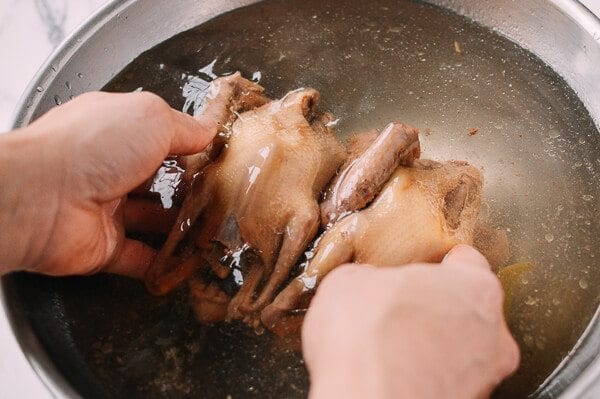
While the squab are cooling in the water, mix together the maltose, Chinese red vinegar, water, and Shaoxing wine until the maltose is dissolved.
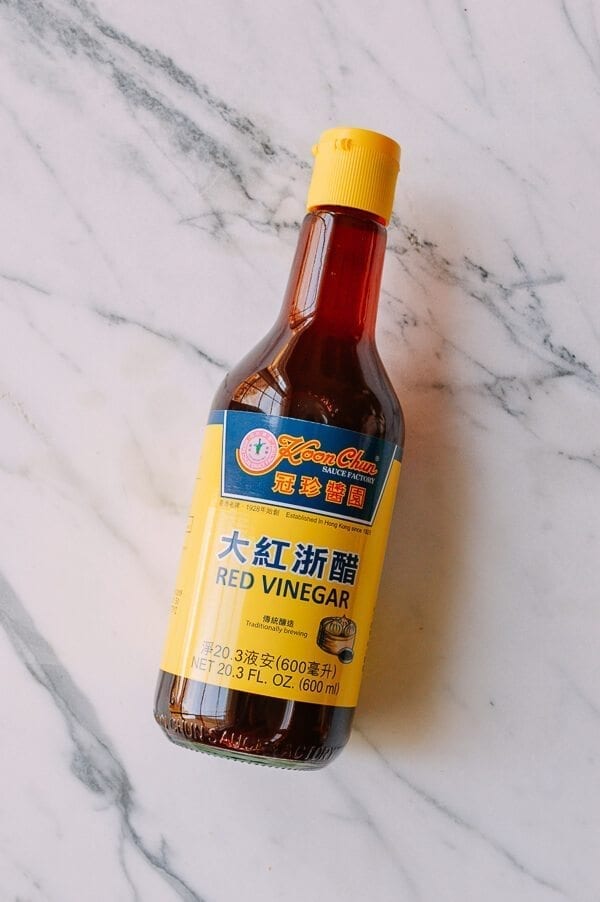

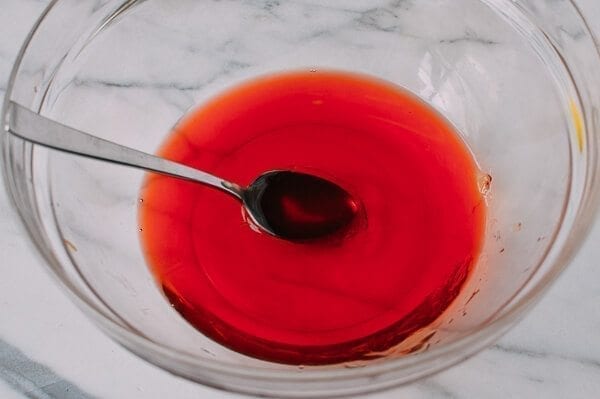
Maltose or Mai Ya Tang is not an easy ingredient to handle. It’s quite stiff and has the texture of taffy. Use your hand to remove the maltose from the measuring spoon and rub it into the water and vinegar mixture to help it dissolve.

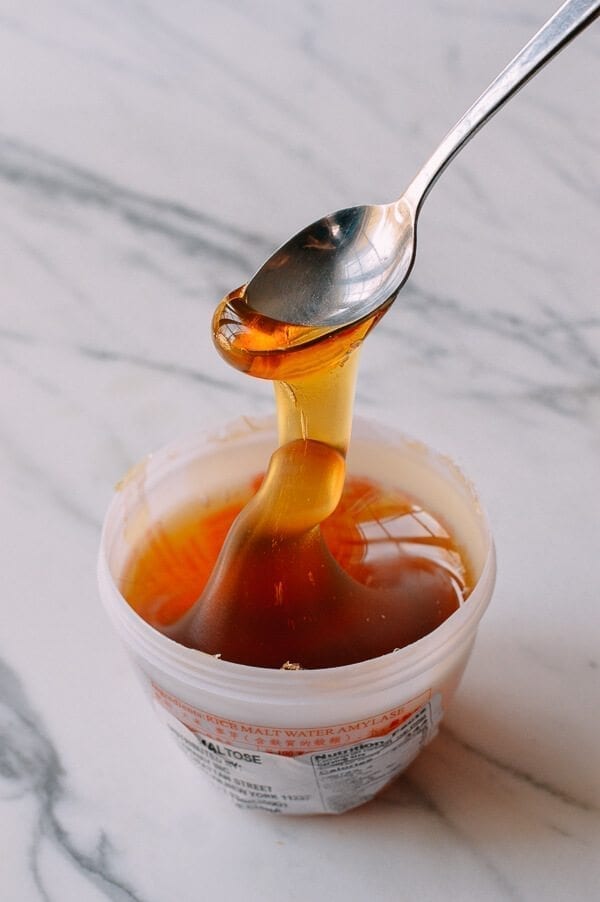
Remove the squab from the water, gently shaking off any excess liquid. Roll the pigeon in the maltose vinegar mixture, using your hands to ensure all of the surface area gets coated. Do your best to keep the vinegar and maltose solution on the outside of the pigeon only. This maltose vinegar bath gives the skin a light coating that ensures crispy skin during the frying process.

Once the pigeons are thoroughly marinated, set aside, and air dry for a total of 2 hours. If you have a fan, point one at the birds to speed up the drying process. Turn the pigeons over after 1 hour and use a towel to wipe any liquid from the plate so it is dry. This bath and drying process is another measure to ensure that your traditional fried pigeon dish will have a crispy skin. The process is a labor of love, so take the time to follow this process to make your fried squab a success!
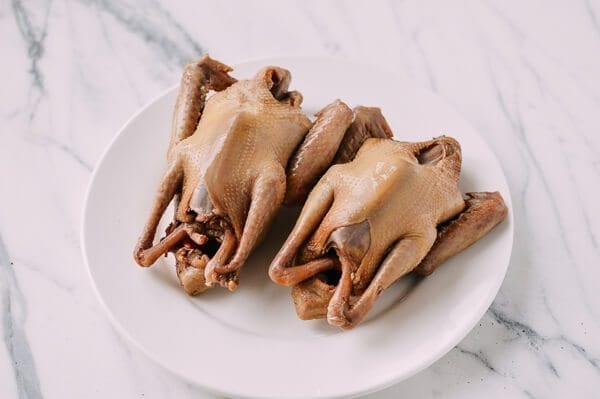
Now it’s time to fry the squab. Heat 6 cups of canola oil to 350 degrees F in a small wok. Use a thermometer to ensure the temperature is accurate. Usually, I recommend a small pot for deep frying to save oil, but in this case, it’s best to use a small round bottomed wok for frying for the following reasons:
- The round-bottomed wok will give you a larger vessel to work with since you will be using a ladle or metal hoak to continually pour hot oil over the fried pigeon.
- You’ll be using a Chinese spider strainer or a regular strainer for these fried pigeons, because you want to prevent the pigeon from directly touching the bottom of the wok which will result in scorching or burning.
- The wok and Chinese spider strainer will give you more control during the frying process–you really don’t want to just completely submerge the squab in oil. The result may be a dry, over-fried squab!
Once your oil has come up to temperature, place one of the squab on the Chinese spider strainer breast down, and carefully lower it into the hot oil. At the same time, use your metal hoak or ladle to repeatedly spoon hot oil over the top of the pigeon. Make sure you pour hot oil over the head, neck, legs and tail. Try to angle the pigeon so the cavity opening is pointed down. Don’t pour oil into the cavity.
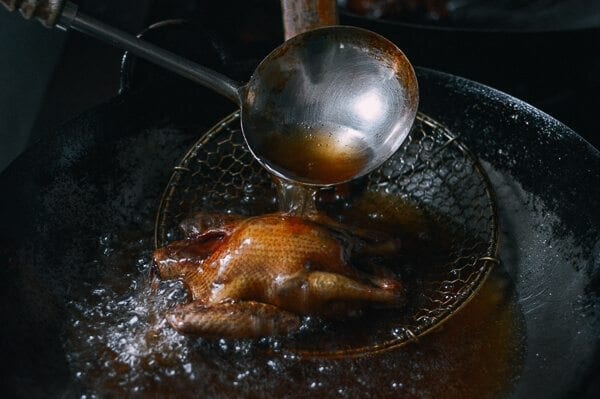
Repeat this process, turning the squab over if needed until your fried pigeon is a uniform amber color. How dark you want your fried pigeon is a personal preference. My experience eating this dish at restaurants is that they are generally a darker amber color. Repeat the process, one-by-one, for the rest of the squab.
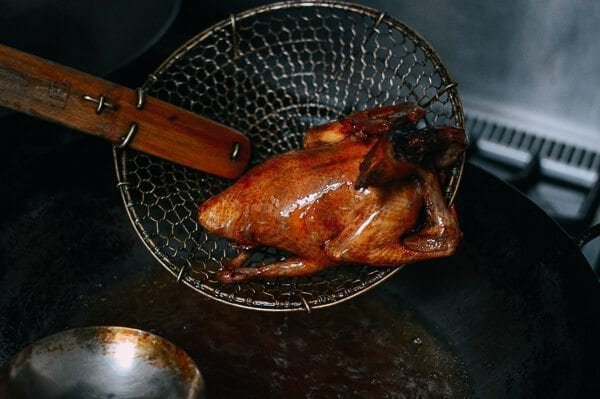
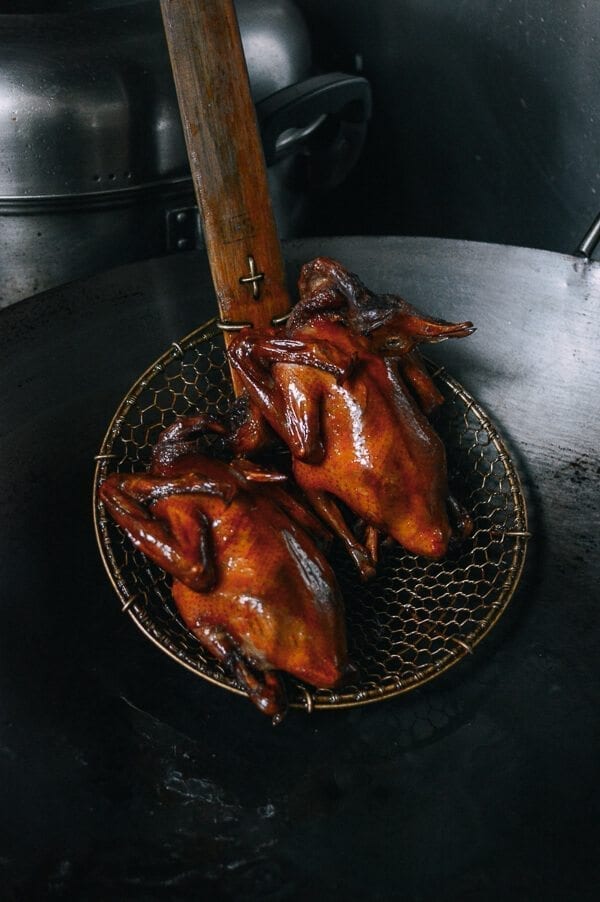
The way to serve these fried pigeons is to cut off the head and place them at the head of the plate. We do the same thing for Cantonese Ginger Scallion Lobster.
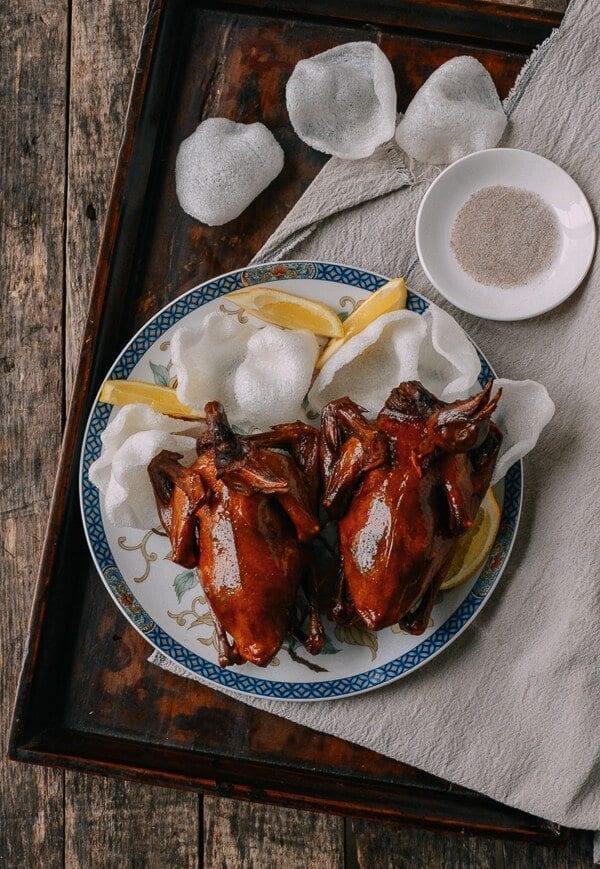
Cut off the claws and set them at the bottom of the plate opposite the heads. Next, use a chef’s knife or kitchen shears to cut the fried pigeon in half lengthwise and cut each half into a breast and leg quarter piece for a total of four pieces.
Arrange the fried pigeon pieces on a large plate with freshly fried shrimp chips (you can quickly make these after you’ve finished frying the squab. Read more about them here: Shrimp Chips – Ha Peen), lemon wedges and your five spice salt on the side.
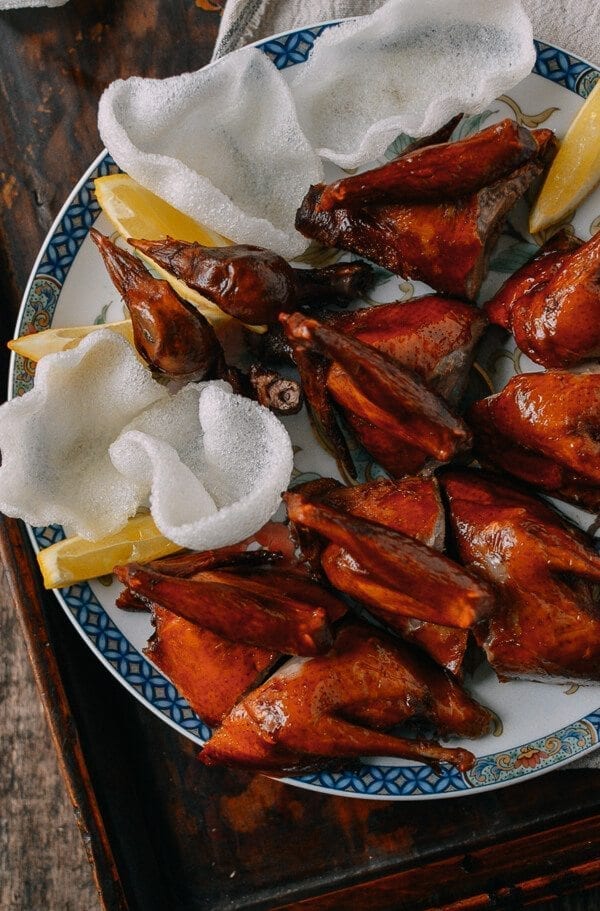
Squeeze a little bit of fresh lemon juice over your fried pigeon before you take a bite – it’s a traditional extra fragrant acidity to cut the richness of the fried squab. Sprinkle come five-spice salt to get a little flavor bump or if you’re enjoying your fried pigeon with an ice cold beer!

This is a true showstopper and centerpiece for Chinese New Year! Chinese Fried Pigeon is a rare and coveted dish that will ring in an auspicious and prosperous new year!
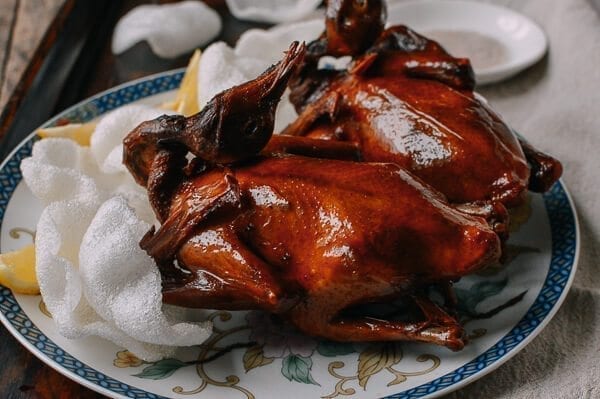
Looking for more authentic recipes? Subscribe to our email list and be sure to follow us on Pinterest, Facebook, Instagram, and Youtube!
Recipe
Chinese Fried Pigeon (Squab), A Hong Kong Favorite
Ingredients
Here’s what you’ll need:
- 2 whole squab
- 3 ⅛-inch thick ginger slices (smashed)
- 3 cloves garlic (smashed)
- 1 scallion (cut into large pieces and smashed)
- 10 g rock sugar (or granulated sugar)
- 3 tablespoons salt
- ¼ cup Shaoxing wine
- ¼ cup light soy sauce
- 1 Chinese spice packet for braising
- 8 cups water (enough to cover the squab)
To coat the pigeon before frying:
- 2 tablespoons maltose
- ¼ cup Chinese red vinegar
- ⅓ cup water
- 1 teaspoon Shaoxing wine
- 6 cups canola oil (for frying)
For serving the fried pigeon:
- Shrimp Chips – Ha Peen (Optional)
- Lemon wedges
- Dipping salt (a few pinches of five spice powder mixed with 1½ teaspoons salt)
Instructions
- Make sure the pigeon/squab are cleaned well, removing any internal organs. Squab in the US almost always come frozen, and oftentimes, they only come dressed on the outside, which means that you must cut a small opening near the tail in order to remove the remove the organs and clean the inside.
- Take care to cut a small opening, and not to rip the skin when cleaning it. The best cut to make is a small horizontal cut 1 to 1½ inches wide between the tail and the bottom of the breast. It’s the same place where all poultry are cut and cleaned out. Once the cut is made, you’ll have to carefully use two fingers to pull out the entrails–including the heart, gizzard, liver, lungs and any glands that are attached to the cavity. It will take a few passes and lots of rinsing with cold water to get them cleaned out.
- After the insides are thoroughly cleaned, use kitchen shears to clip off the talons and tuck the feet inside the cavity. You can also just cut off the claws (some old folks like to eat them with a cold beer) and just leave the legs. For a Chinese New Year bird, Chinese people tend to leave the legs, tail, and head intact. It is an old Chinese tradition to serve any bird with both the head and tail on for Chinese New Year dinner. It’s true also for the classic poached chicken, Cantonese white cut chicken, which is a required dish at all Cantonese Lunar New Year dinners!
- In a medium-sized pot, add the ginger, garlic, scallions, sugar, salt, Shaoxing wine, soy sauce, Chinese spice packet, water, and bring to a boil. The liquid should be quite salty––almost as salty as the sea, like when you cook pasta. Turn the heat down and let the sauce simmer for 15 minutes.
- Next, carefully place the squab into the pot until they are fully submerged, and the cavities are filled with the hot liquid. Lift the squab out, emptying the liquid inside the cavity and return them back to the pot, again ensuring there are no air pockets in the cavity. This is the same method used in our classic Cantonese poached chicken; it ensures that there are no cold spots and that the poultry cooks evenly.
- Reduce the heat to the lowest setting so the liquid is almost (but not actually) simmering. Let the squab cook for 30 minutes. Another easier method is to let the liquid simmer for 5 minutes with the squab, then turn off the heat completely, and leave the pot covered on the stove for another 25 minutes.
- While the squab is cooking, prepare a large bowl of cold water. After the squab are done, remove them from the braising liquid, and soak them in the cold water, gently rubbing off any impurities from the skin that may have appeared from the cooking process. Let them cool completely in the water.
- While the squab are cooling in the water, mix together the maltose, red vinegar, water, and Shaoxing wine until the maltose is dissolved. Maltose is not an easy ingredient to handle. It’s quite stiff and has the texture of taffy. Use your hand to remove the maltose from the measuring spoon and rub it into the water and vinegar mixture to help it dissolve.
- Remove the squab from the water, gently shaking off any excess liquid. Roll the pigeon in the maltose vinegar mixture, using your hands to ensure all of the surface area gets coated. Do your best to keep the vinegar and maltose solution on the outside of the pigeon only. This maltose vinegar bath gives the skin a light coating that ensures crispy skin during the frying process.
- Once the pigeons are thoroughly marinated, set aside, and air dry for a total of 2 hours. If you have a fan, point one at the birds to speed up the drying process. Turn the pigeons over after 1 hour and use a towel to wipe any liquid from the plate so it is dry. This bath and drying process is another measure to ensure that your traditional fried pigeon dish will have a crispy skin.
- Now it’s time to fry the squab. Heat 6 cups of canola oil to 350 degrees F in a small wok. Use a thermometer to ensure the temperature is accurate. Usually, I recommend a small pot for deep frying to save oil, but in this case, it’s best to use a small round bottomed wok for frying.
- Once your oil has come up to temperature, place one of the squab on the Chinese spider strainer breast down, and carefully lower it into the hot oil. At the same time, use your metal hoak or ladle to repeatedly spoon hot oil over the top of the pigeon. Make sure you pour hot oil over the head, neck, legs and tail. Try to angle the pigeon so the cavity opening is pointed down. Don’t pour oil into the cavity.
- Repeat this process, turning the squab over if needed until your fried pigeon is a uniform amber color. How dark you want your fried pigeon is a personal preference. My experience eating this dish at restaurants is that they are generally a darker amber color. Repeat the process, one-by-one, for the rest of the squab.
- The way to serve these fried pigeons is to cut off the head and place them at the head of the plate. We do the same thing for Cantonese Ginger Scallion Lobster. Cut off the claws and set them at the bottom of the plate opposite the heads. Next, use a chef’s knife or kitchen shears to cut the fried pigeon in half lengthwise and cut each half into a breast and leg quarter piece for a total of four pieces. Arrange the fried pigeon pieces on a large plate with freshly fried shrimp chips (you can quickly make these after you’ve finished frying the squab), lemon wedges and your five spice salt on the side.





